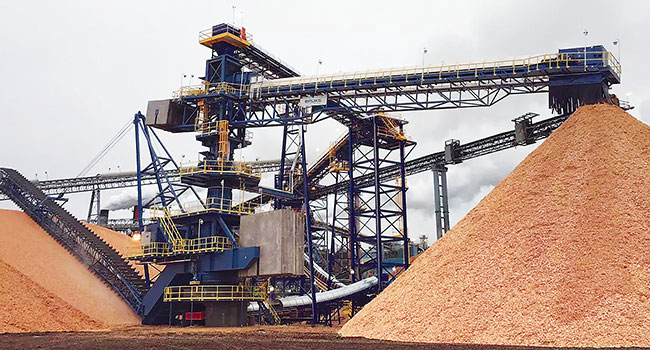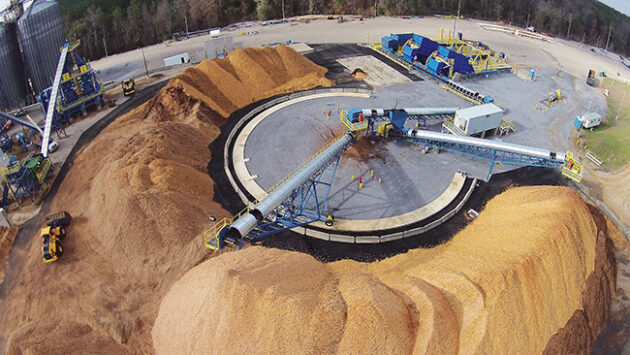
Moving the masses: handling and storage solutions
November 17, 2023
By Joanne Turnell
 A Bruks circular overpile stacker reclaimer. Photos courtesy Bruks Siwertell.
A Bruks circular overpile stacker reclaimer. Photos courtesy Bruks Siwertell. Biomass, the collective term for organic material used as fuel in power generation, is increasingly becoming mainstream. In Liverpool, England, two Bruks Siwertell multi-fuel screw-type unloaders serve Associated British Ports’ Immingham Renewable Fuels Terminal. The ST 790-D-type units are used for unloading imported biomass pellets to fuel the nearby Drax power station, which supplies between seven and eight per cent of the UK’s electricity demand.
Managing the huge volumes of organic material required for these booming industries requires an expert touch, not only to ensure the quality of the material, but also the safety of the storage pile and its efficient management as it travels along the processing line with dust-free and cold weather-contained conveying solutions.
All these elements are tied up in each other, and automation is proving to be the solution. A popular choice is a fully automated woodyard which includes full automated stacker reclaimers. Woodyards can expertly manage vast, neat swathes of wood chips and various other materials.
At the recently shuttered Domtar Espanola, Ont., facilities, Bruks cold weather stacker reclaimers were installed in 1997 by the Spanish River Pulp & Paper Company, (acquired by Domtar in 1998). The mill produced 69,000 tons of over 200 different grades of technical and specialty paper every year, including northern bleached softwood kraft pulp. A 280,000-ton annual capacity fibre line was fed a mix of aspen, maple and birch hardwood chips, and meeting this appetite for more than 25 years, was cold weather stacker reclaimers. The two fully automated circular systems, with a beam length of 41.5m, operated almost continuously, even in the harshest winters, with minimal operator intervention and downtime.
Intelligent technology
Fully automated full circle stacker reclaimers can lay down successive layers of material in a continuous 360-degree rotational pattern using a stacking conveyor that pivots through a complete circle. At ground level, a reclaim bridge moves into the pile with a harrow simultaneously agitating and fluidizing the material on its reclaiming face. A large diameter screw catches all the falling material and transfers it to the center where it drops onto the reclaim belt. This passes under the pile and emerges beyond its edge, leaving the base undisturbed. A first-in first-out (FIFO) mechanism can ensure the oldest material in the pile is always reclaimed first and is blended reduce any variation to a minimum.
Automation has brought considerable benefits to woodyards. Fully automated stacker reclaimers minimize the number of personnel-hours required for daily operations, delivering significant cost savings. They have a unique design that improves inventory control, as well as maintaining consistent quality.
Automated systems also have a fraction of the carbon footprint of a manually managed pile and offer much improved emissions control. These environmental gains stem from eliminating the continuous use of diesel-powered machines used to manage the piles. Fugitive dust emissions are also reduced in comparison to them, as the gentle nature of circular blending bed stacker reclaimers mean that they do not stir up fines and dust.
Bioenergy growth
With biomass demand increasing worldwide, getting the highest possible energy content for the end user requires every stage of the biomass production process to be handled with care.
At the U.S. Greenwood Colombo Energy plant in South Carolina – owned and operated by the world’s largest producer of industrial wood pellets, Enviva – several Bruks systems are in operation. The site has undergone a number of modernizations since opening in 2016, including the adoption of a fully automated woodyard.
The plant either takes delivery of pre-processed wood chips via its two back-on truck dumpers, or takes delivery of full logs which are then processed in a drum chipper to turn them into chips. All wood chips are stacked and stored using a circular blending bed stacker reclaimer. The entire wood-processing and handling operation delivers a very efficient system that benefits from all the advantages of automation, ensuring the plant’s highest yields.
Enviva Biomass also operates a Bruks circular blending bed stacker reclaimer at its Green Circle Bio Energy Inc plant in Cottondale, Fla. It began operations in 2008 and, with the help of its fully automated woodyard, has gone from an annual green wood chip processing capacity of 500,000 metric tons to three million.

Automated storage systems reduce fugitive dust emissions, and lower the carbon footprint of an operation.
Sustainable steps
Mills, pellet plants and power-generation facilities all operate on tightly controlled schedules with very little downtime. Woodyards and all their constitute components should deliver their contents day-in, day-out with the same levels of efficiency, reliability, and material consistency.
Storing and reclaiming organic biomass materials such as wood chips, bark or sawdust is a specialist task. Stacker reclaimers are a combination of technologies that pile and then retrieve dry bulk materials for onward conveying in a very efficient, controlled way. They also blend material, which is particularly important for organic commodities to reduce fibre losses from microbial action and heat build-up in the pile. Stacker reclaimers can form linear, semi-circular and fully circular piles in a range of sizes and capacities.
Varying moisture contents and differences in densities, fibre properties and calorific values are just some of the considerations. Also, most forms of biomass are very dusty, prone to catch fire or in fact self-ignite, and will freeze as well.
Degrading biomass during storage leads to several unfavorable outcomes including greenhouse gas (GHG) emissions, feedstock/energy losses, and economic losses. Optimization of biomass storage along the supply chain for the reduction of these negative effects using a FIFO storage method is essential to improve bioenergy as a renewable and profitable energy source.
The overall effect of the biological, chemical and physical reactions, which occur in dormant biomass piles, leads to a succession of microorganisms as pile temperatures increase, which in turn releases GHG emissions, such as CO2, CH4 and CO, into the atmosphere.
In a FIFO system, the oldest product is reclaimed and processed first, before newer material. Using older material first helps ensure the material a processor utilizes is consistent and keeps your pile moving.
As the global demand for renewable energy intensifies, biofuel plants are being developed and promise the potential of consigning fossil fuels to the past. Part of this increasing commercialization is the growing importance of proven, reliable wood processing technology and biomass storage. •
Joanne Turnell has been in the biomass and wood processing industry for more than 25 years, and is the capital sales representative for Bruks Siwertell in Canada.
Joanne.turnell@bruks-siwertell.com
Print this page